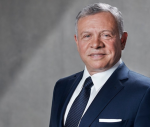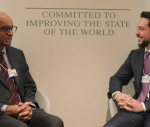You are here
Hizbollah backed government unlikely to get much needed aid
Jan 28,2020 - Last updated at Jan 28,2020
After more than one hundred days of protests that crossed sectarian and party lines Lebanon has a new government under Sunni technocrat Hassan Diab. But it is not the government that protesters had wanted. In fact the 20-member Cabinet reflected the hegemony of the so-called 8 March Stream and the axis of resistance; a coalition of Hizbollah, Amal and the National Patriotic Movement (NPM). Hizbollah had the final say over the composition of the cabinet and can, through one third of loyalist ministers, veto unwanted policies.
Diab was never embraced by the protesters who wanted an independent cabinet that would draft a new election law and call for early elections. They also wanted to oust President Michel Aoun, who is a key ally of Hizbollah. Mass anti-government protests had forced Saad Harriri to resign last October. Protesters wanted to end the decades-old control of the political elite over the country’s institutions and resources. No one was to be spared as protesters denounced the sectarian system that had concentrated power in the hands of the few and resulted in blatant corruption, massive foreign debt, unemployment and poverty.
Violent protests broke out this week as the new government sought to present the 2020 budget to parliament even before winning a vote of confidence or presenting its programme. With key political players like Harriri’s Future Party, Samir Geagea’s Lebanese Forces and Walid Junblatt’s Progressive Socialist Party sidelined, Diab’s government will have a tough time passing laws and launching its reform program. In fact, Diab is already running out of time as the country may soon default on bond payments. He has few weeks to convince key creditors, like France and the United States, to provide much needed funding to rescue the country’s ailing economy. Between $5 billion and $20 billion is needed to save Lebanon’s banks, which have been forced to restrict the ability of clients to withdraw their money, particularly in US dollars.
For the International Monetary Fund to step in it needs Washington’s approval, something that is unlikely to take place for now. Only France appears to be willing to deal with Diab’s government while the United States views it as Hizbollah’s own. In fact, one wonders why Hizbollah has chosen to alienate its rivals and back a one-shade cabinet that would certainly be rejected by Washington. The role played by discredited pro-Syria politician, Jamil Al Sayyed, in the formation of the government has alarmed Lebanese politicians and ordinary citizens.
One explanation to why Hizbollah has chosen to take a leading role in the new government lies in the fact that Lebanon has become another arena in the open US-Iran showdown. It goes without saying that Hizbollah’s main concern is not the immediate stability of Lebanon but serving Iran’s regional agenda. Aoun’s only interest seems to be to stay as president no matter the cost and his controversial son-in-law Gebran Bassil, who heads the FPM, is bent on remaining a central figure in the Lebanese political landscape.
One threat that Hizbollah’s gambit may bring about is heightened sectarian tension as Sunnis and Druze, in particular, feel increasingly alienated. Does Hizbollah’s Hassan Nasrallah, now given additional responsibilities by Tehran following the killing of Gen. Qassem Soliemani, understands that failure of Diab’s government will mean the collapse of Lebanon’s economy?
More importantly is the fact that Diab’s failure will be pinned directly on Hizbollah and its allies, dragging the Shia party to the forefront, when in the past it was satisfied to take a back seat and control from the shadows.
For Washington and despite statements that it would want to see genuine reforms adopted as fast as possible to be convinced to offer credit, political priorities will affect its intentions. The showdown with Iran has reached new levels and the US is hoping that the strangulation of the Iranian economy will unleash popular protests that would either force Tehran to negotiate a new nuclear deal or bring about the collapse of the regime. Putting pressure on Iran’s proxies in Iraq and Lebanon is part of that strategy.
Time is not on Diab’s side and his efforts to launch genuine reforms will be opposed by the elite political class that has a lot to lose. His failure and possible departure will be catastrophic for Lebanon. Hizbollah may be hoping that if that happens it can lure Harriri back to take over. But it forgets one thing: Lebanon, after 17 October, is different. The protesters are not going home anytime soon and their grievances will only increase as the political impasse lingers.
Osama Al Sharif is a journalist and political commentator based in Amman













